This post may contain affiliate links. Please read our disclosure policy.
These littleneck clams steamed in white wine, surrounded by aromatics, and rich in umami from chorizo will be the most flavorful clams you’ll eat. The zesty clams and chorizo broth is deliciously soaked up with your favorite bread or pasta!
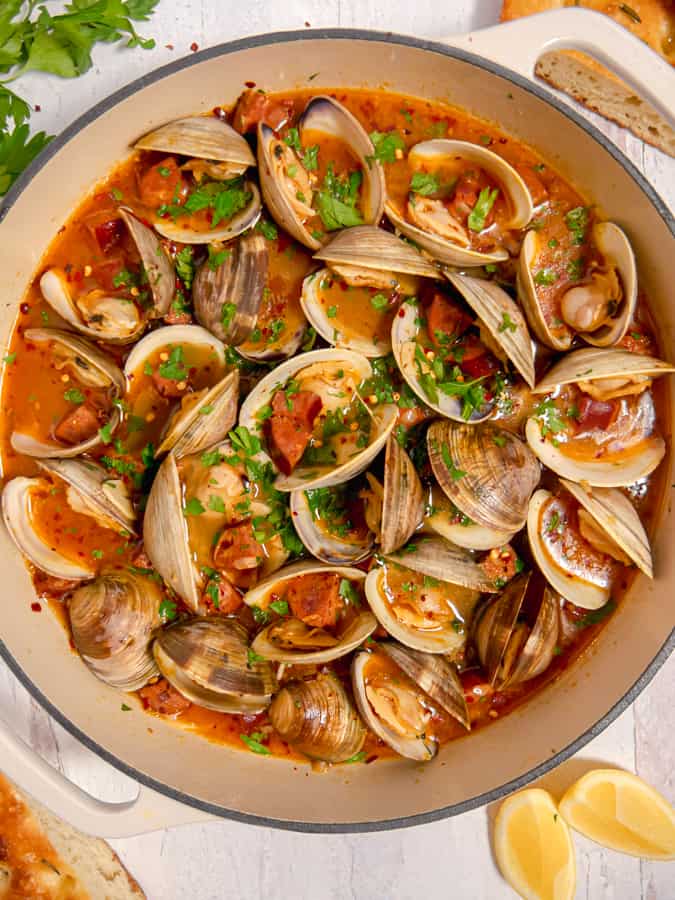
What are clams?
Clams are a type of mollusk, and they live most of their lives buried in the sand. They have a similar taste to oysters – buttery and pretty chewy. Since they live in sandy seawater, they have a very salty flavor too!
They are also a lot like mussels. Both mussels and clams live in either saltwater or freshwater and are served in their shells.
Clams can be served raw or cooked and are often either steamed or boiled.
Why this clams and chorizo recipe works
- This recipe looks a lot more complex than it is. You can serve it to guests and impress everyone even though it is a really simple recipe.
- The spices and chorizo cut the fishy taste of the clams, which is good news for anyone that struggles with the flavor.
- It is easy to customize this recipe. Add your favorite pasta, or dip some crusty bread into the broth.
Clams and chorizo ingredients
Of course, this recipe is made with clams and chorizo – but here is some more information about what I used to make the tasty broth.
- Little neck clams
- Spanish chorizo
- Olive oil
- Shallot
- Garlic cloves
- Anchovy fillets
- Unsalted butter
- Red pepper flakes
- Dry white wine
- Vegetable broth
- Lemon zest
- Fresh chopped parsley
Optional garnish or side ingredients
- Lemon wedges
- Toasted bread (highly recommend this roasted garlic bread!)
- Pasta
How to prep the clams

Email this Recipe!
Email this recipe to yourself to save for later.
By submitting this form, you agree to receive emails from Girl with the Iron Cast.
Little neck clams are my favorite type to use for this clams and chorizo recipe! They are small, tender, and steam well.
Clam tip:
When buying clams, do a simple ‘tap’ test. Gently tap them together, and they should fully close their shells. If they don’t, they could be dead or dying, and you should discard them. Also, discard any that are broken open!
Soaking clams
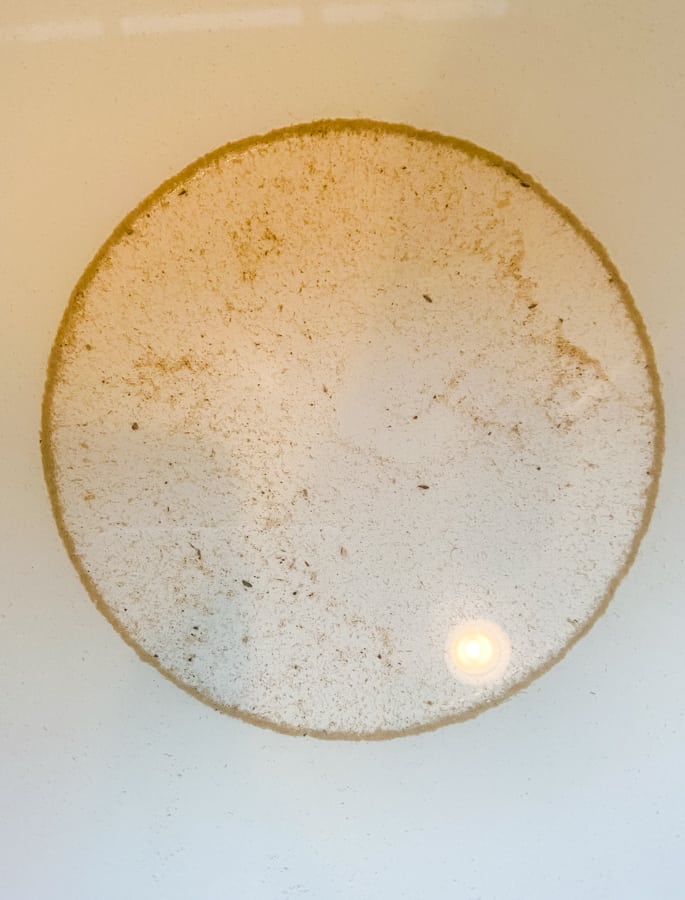
Since clams live on the ocean floor, it makes sense that they have a bunch of sand inside. But, you don’t want to ruin a dish by slurping up clams with a side of sand.
So, I soak my clams for 30 minutes, and as they drink up the fresh water, they ‘spit’ the sand out.
To soak:
- Place the clams in a colander and then put that in a bigger bowl filled with cold water.
- The colander allows the sand to fall to the bottom of the bowl, so the clams can’t drink it back up. See above how much sand came out.
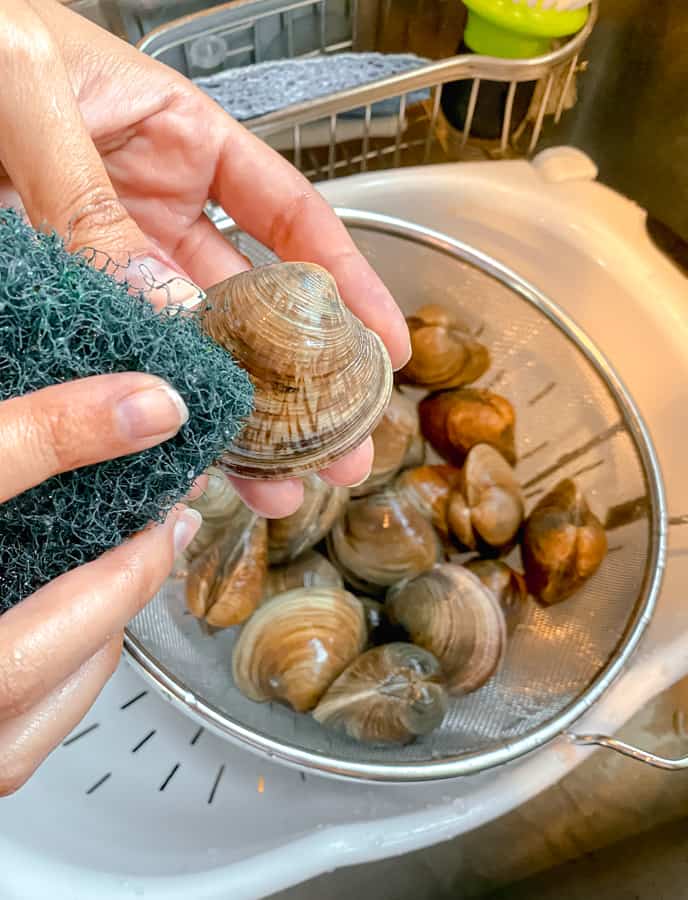
- Once you have soaked the clams, dump the sand water and scrub each clam to remove any sand or grit from the shell.
Now they are ready to be cooked!
What is chorizo?
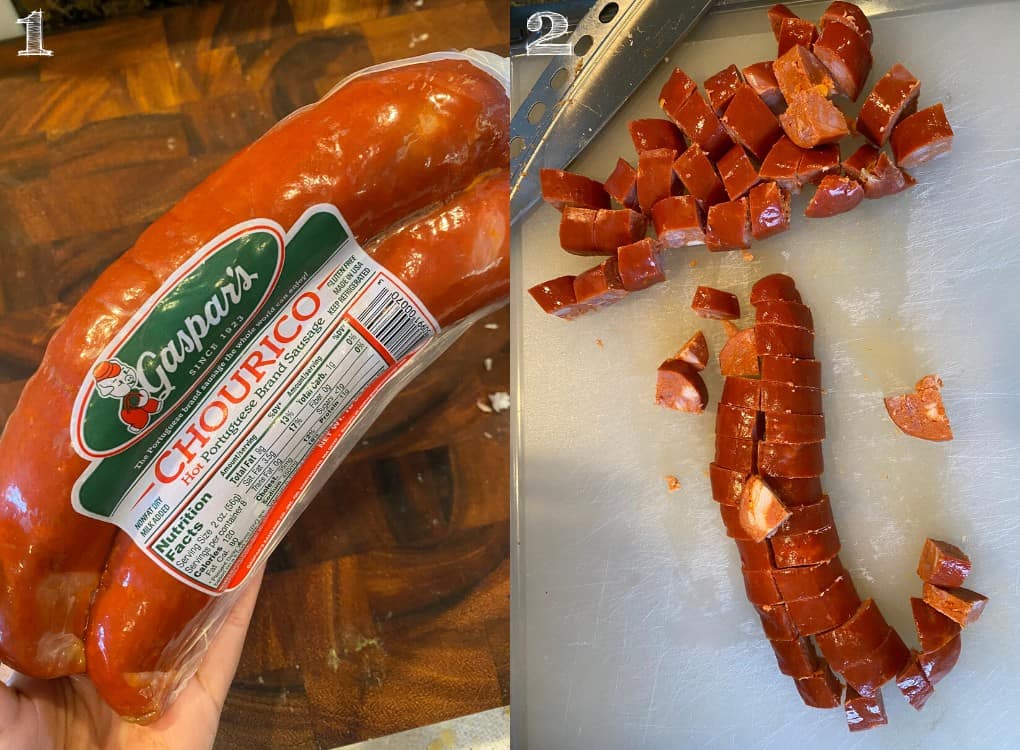
Growing up Portuguese, you’re taught that pretty much everything tastes better with chorizo added.
Chorizo (or Chouriço) is a smoked par-cooked pork sausage seasoned with hot paprika and spices. It is different than Mexican chorizo, which comes raw/uncooked.
For this recipe, take the chorizo and slice vertically and once more to have small bite-sized pieces.
How to create a savory broth
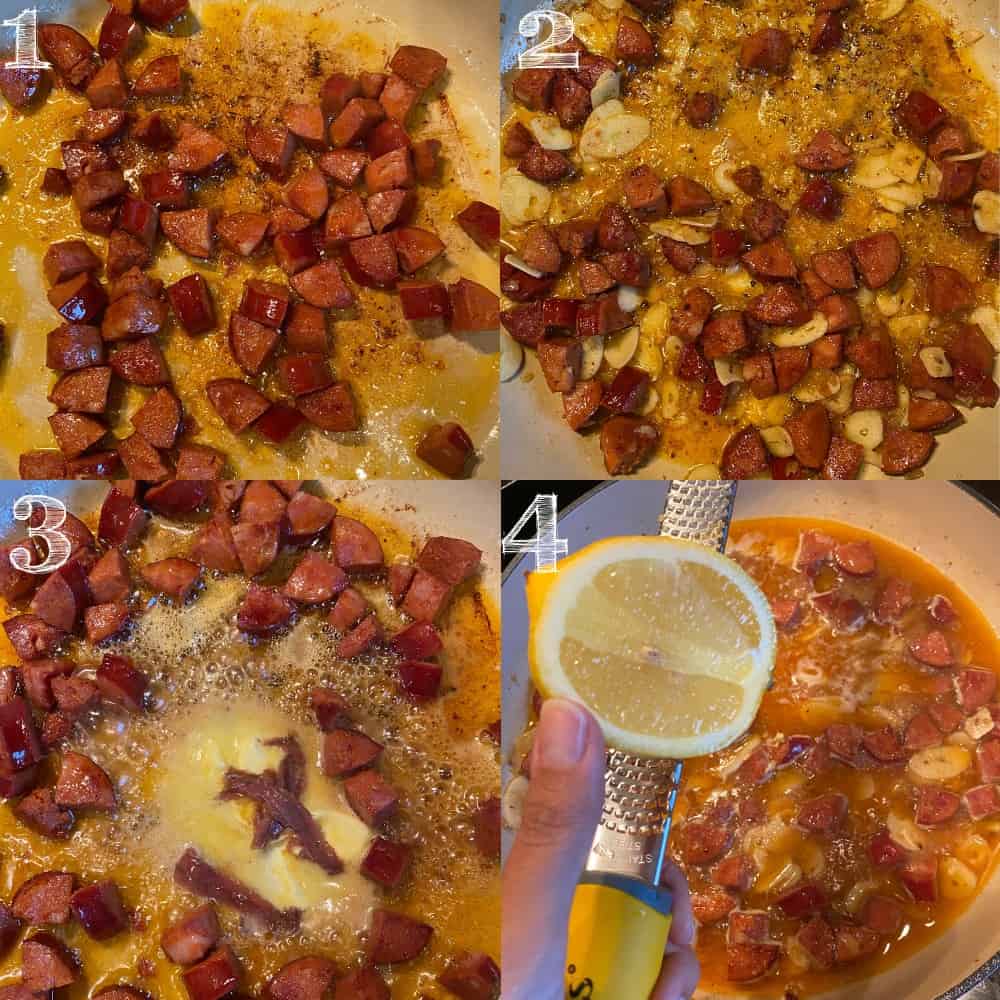
To make a delicious clam broth:
- Even though chorizo is already par-cooked, brown the chorizo to make it crisper and to release flavorful juices. This takes about 4-5 minutes.
- Add minced shallot and thinly sliced garlic (use a mandoline) to the skillet and sauté them until fragrant.
- Add 4 anchovy filets and butter to enrich the seafood taste, so the chorizo doesn’t overpower the flavor of the dish. The filets will dissolve into the oil.
- Deglaze the pan with white wine and scrape up the delicious browned bits on the bottom of the pan.
- Next, add vegetable broth, red pepper flakes, and lemon zest.
Broth tip:
The broth should be lightly boiling!
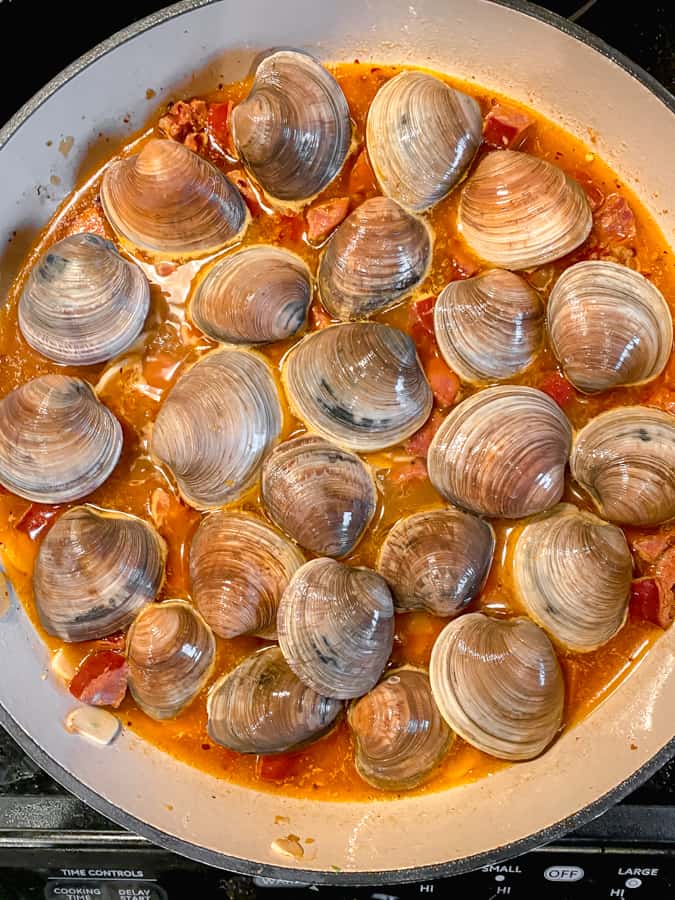
- Gently nestle your clams into the chorizo broth and cover with a tight-fitting lid.
- Allow the clams to steam for 5-7 minutes.
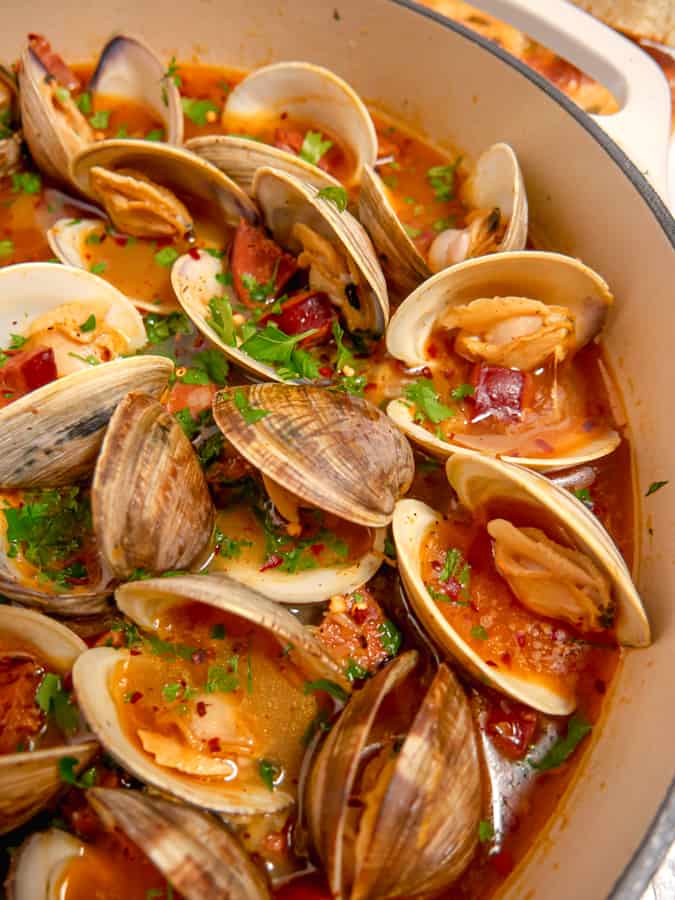
Clam cooking tip:
If clams haven’t opened after 5-7 minutes, give your pan a shake to get those stubborn clams movin’! Be careful and don’t cook them for too long, or they will become tough and rubbery.
Some clams will not open as fully as others, and those are still okay to eat. Just use a knife to open them when eating.
If a clam has a bad smell, that is a sign it needs to be tossed.
How to serve brothy clams and chorizo

Once the clams are steamed open, I top them with fresh parsley!
This dish is to be served in bowls and enjoyed with freshly toasted bread to soak up all the delicious broth. You may also prepare pasta and ladle the broth and clams over the top.
Serve with a lemon wedge on the side, and enjoy!
How to store clams with chorizo
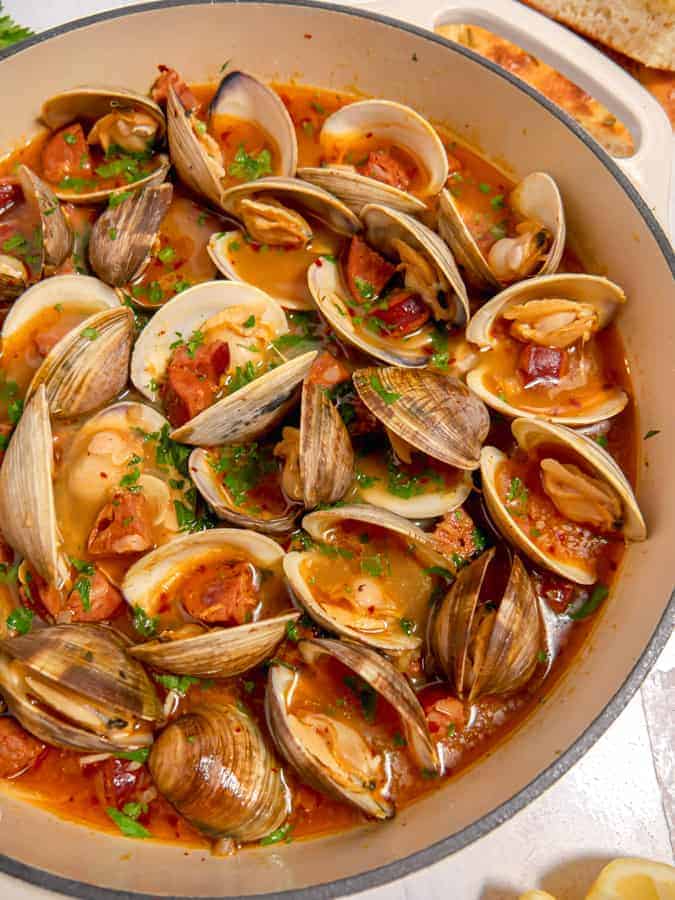
This clams and chorizo dish is best enjoyed fresh and right away. Clams cool quickly and get kind of rubbery when cold.
If you need to store leftovers, do so in the refrigerator and carefully reheat them in the microwave.
Storage tip:
Do not freeze – it will alter the taste and consistency of the clam!

Looking for other seafood recipes?
Did you make this? If you snap a photo, please be sure tag me on Instagram at @girlwiththeironcast or hashtag #girlwiththeironcast so I can see your creations!
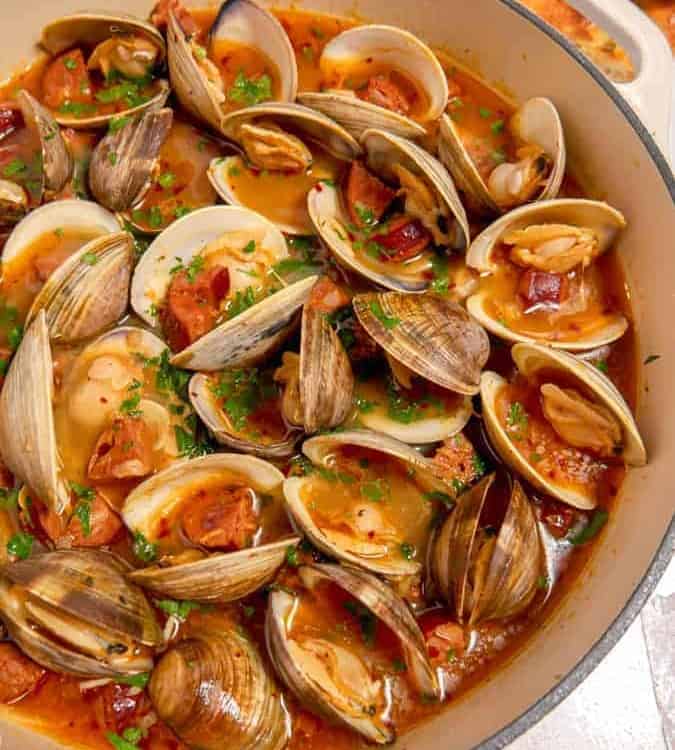
Clams and Chorizo
Ingredients
- 24 little neck clams
- 1 link Spanish/Portuguese Chorizo [see note 1] (diced (1/4 cup))
- 2 tablespoons olive oil
- 1 shallot (minced (1 1/2 tbsp))
- 6 cloves garlic (thinly sliced (mandoline))
- 4 anchovy filets in oil
- 2 tablespoons unsalted butter
- 3/4 teaspoon red pepper flakes (omit for less spicy)
- 125 milliliters dry white wine
- 1 cup vegetable broth
- 2 teaspoons grated lemon zest
- 1 tablespoons freshly chopped parsley
Garnish/Side
- Lemon Wedges
- Toasted Bread
- Optional: Pasta
Email this Recipe!
Email this recipe to yourself to save for later.
By submitting this form, you agree to receive emails from Girl with the Iron Cast.
Before You Begin! If you make this, please leave a review and rating letting us know how you liked this recipe! This helps our business thrive & continue providing free recipes.
Instructions
- See note #2 on buying clams. To prep the clams, place them in a colander and place the colander in a larger bowl. Fill the bowl with fresh cold water until all the clams are submerged. Allow the clams to sit in the cold water for 30 minutes to spit the sand from inside their shells. After 30 minutes, remove the colander from the bowl (sand should be at bottom of bowl) and gently scrub each clam to remove any remaining grit or sand.
- In a pot or high walled skillet, over medium heat, add 2 tbsp olive oil and diced chorizo. Sauté chorizo for 4-5 minutes until it begins to brown. Add in the minced shallot and thinly sliced garlic, sauté for one minute until fragrant. Add in 2 tbsp unsalted butter, 4 anchovy filets, and crushed red pepper flakes. Mix all ingredients until anchovies dissolve.
- Pour white wine in and deglaze the pan, scraping up the browned bits on the bottom of the pan. Allow the wine to reduce for 3 minutes. Pour in the vegetable broth and add the lemon zest. Stir to combine all ingredients.
- Allow broth to come to gentle boil and carefully nestle the clams into the broth. Cover with a tight fitting lid and allow clams to steam for 5-7 minutes. Every few minutes give the pan a shake to help stimulate the clams [see note #3].
- Once clams are finished cooking, top with fresh parsley and serve immediately. Using a ladle, ladle broth and clams into a bowl and serve with fresh lemon wedges and toasted bread to soak up the broth. Optional: to turn into a more hearty meal, you can cook pasta and ladle clams and broth over the top.
Notes
- Spanish/Portuguese chorizo is par-cooked, do not use Mexican chorizo which comes raw/uncooked
- When buying clams, do a simple ‘tap’ test. Gently tap them together, they should full close their shells, if they don’t they could be dead or dying and you should discard. Also discard any that are broken open.
- Be careful and don’t cook clams for too long, or they will become tough and rubbery. Some clams will not open as fully as others and those are still ok to eat, use a knife to open them when eating. If a clam has a bad smell, that is a sign it needs to be tossed.
- This dish is best enjoyed fresh and right away. Clams cool quickly. If you need to store leftovers, do so in the refrigerator and carefully reheat in the microwave. Do not freeze, will alter taste and consistency of clam.


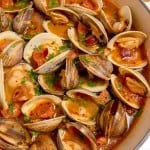
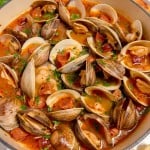
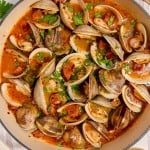


I have a house in Mexico and we go clamming right in front of our house. We get the smaller “butter clams” (I don’t know what they’re really called) we have tried almost every way you can imagine to cook clams over the years. This recipe has become a family favorite!! Wow!! It is DELICIOUS! My family absolutely loves clams and I didn’t think there would be a time we would settle on a favorite, but this recipe won out!! I’m actually making it tonight. I always make fresh bread for dipping, there’s never a drop left in anyone’s bowl or the cast iron pan! I’m glad I found the recipe and it is so easy to make! LOVE IT!!
Hi Jet, I am so jealous that you not only get to source your own clams but that it is right by your house! Amazing! I am so glad that you and your family love this recipe, thank you so much for making it and for your kind words. Cheers!
had a similiar dish in restaurant but with fried calamari, chourizo and sauce. could I use this saucefor it. The name of dish was portugese style calamari ?
Yes! I think that this would be delicious with calamari
Made this for our family of 6. Rave reviews all round
I did this excellent recipe several times but modified it by adding tomato paste, whole tarragon (removed before serving), dried mint with mussels and shrimps. The basics of this recipe is so perfect that any modification can be made if desired.
The recipe sounds great but I’m wondering if I can substitute mussels for clams.
Hi Rhonda, yes you can substitute mussels for clams
This was SO flavorful and the perfect meal for my husband and I. I felt like I was on the coast with these flavors, the chorizo and wine and broth all together. Highly recommend!
I’m so glad you and your husband loved it Laura! Thank you for making it.
I never thought these flavors could be so easy! Wonderful results with a really manageable recipe, some good Cape littlenecks and supermarket Chourico. Served it in bowls over pasta. Loved the anchovies and no one needs to know!
So glad you enjoyed this dish Nick! Your anchovy secret is safe with me!
Just made it tonight see how it goes the sauce it cooked in seems very flavorful I don’t eat clams but my fiancée loves them so I had to try
Wow! that is a combination that I never thought about before. I can see that my parents would totally love this dish. It may be a good idea to cook it for them next time they visit!
Thanks Laura! I hope they love it
Loved this recipe. The chorizo flavors go so well with the littleneck clams. I wanted to save the broth and drink the next day as a soup!
Thanks Billy! I’m so glad you enjoyed it. That broth is really liquid gold!